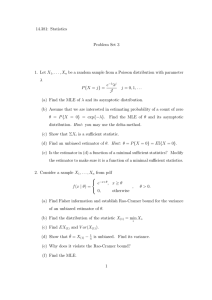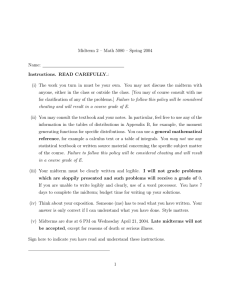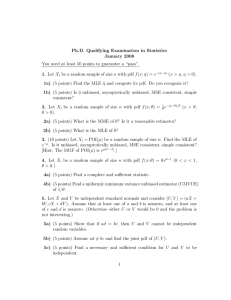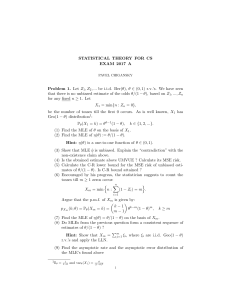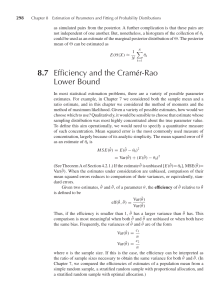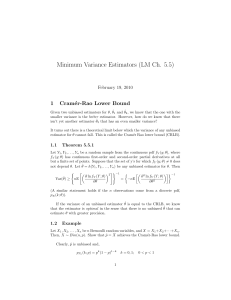15 Solutions
advertisement
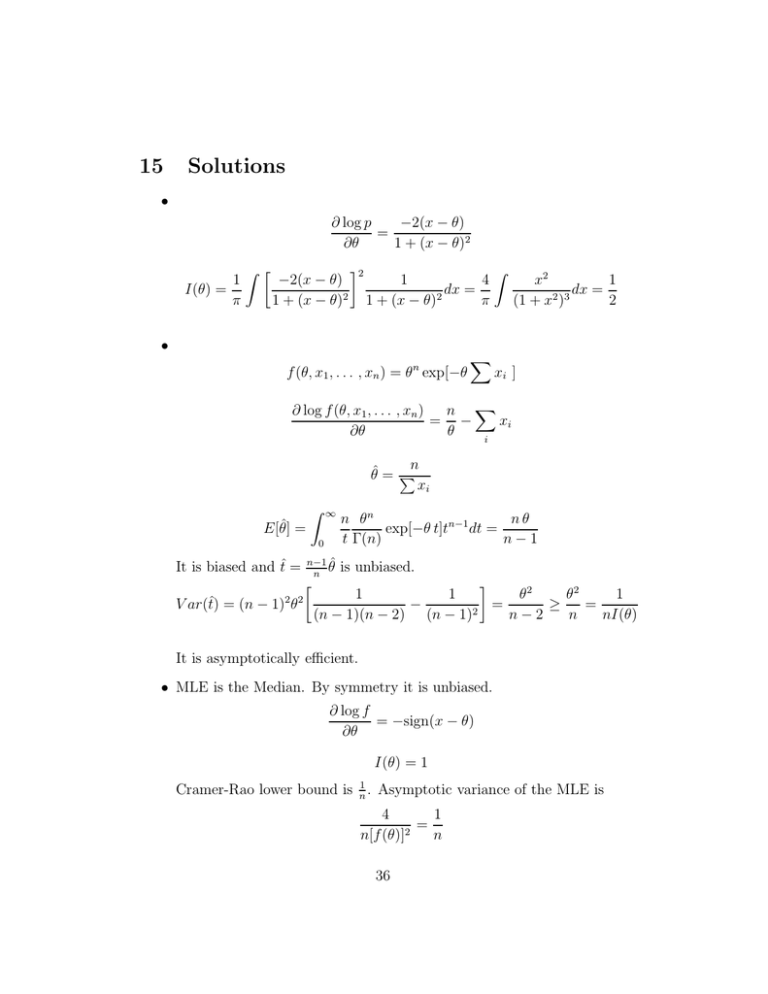
15 Solutions • ∂ log p −2(x − θ) = ∂θ 1 + (x − θ)2 1 I(θ) = π Z −2(x − θ) 1 + (x − θ)2 2 1 4 dx = 2 1 + (x − θ) π • f (θ, x1 , . . . , xn ) = θn exp[−θ X Z 1 x2 dx = 2 3 (1 + x ) 2 xi ] n X ∂ log f (θ, x1 , . . . , xn ) = − xi ∂θ θ i n θ̂ = P xi Z E[θ̂] = It is biased and t̂ = 2 2 V ar(t̂) = (n − 1) θ ∞ 0 n−1 θ̂ n n θn nθ exp[−θ t]tn−1 dt = t Γ(n) n−1 is unbiased. 1 1 θ2 1 θ2 − ≥ = = 2 (n − 1)(n − 2) (n − 1) n−2 n nI(θ) It is asymptotically efficient. • MLE is the Median. By symmetry it is unbiased. ∂ log f = −sign(x − θ) ∂θ I(θ) = 1 Cramer-Rao lower bound is n1 . Asymptotic variance of the MLE is 1 4 = 2 n[f (θ)] n 36 • A statistic is T (0), . . . , T (n). Unbiased means X n 3 j 1 n−j j and j 4 4 X n 1 j 3 n−j j j 4 4 T (j) = 3 4 T (j) = 1 4 Two equations. n + 1 unknowns. Lots of solutions. Easy to construct unbiased estimators with variance that is very small. For example if n is odd T (x) = a if x < n2 and T (x) = b if x > n2 can be made unbiased by proper choice of a and b. If we denote by X n 3 j 1 n−j X n 1 j 3 n−j pn = = j 4 j 4 4 4 n n j< 2 j> 2 we need apn + b(1 − pn ) = and 1 4 3 4 n −1 and b = 4p . The variance is given by 8pn −4 a(1 − pn ) + bpn = giving us a = 4pn −3 8pn −4 1 1 σ 2 = pn (a − )2 + (1 − pn )(b − )2 4 4 and is seen to be very very small for large n. • The log-likelihood is n 1 X 1 X 2 X n n − log θ − (xi − θ)2 = − log θ − xi + xi − θ 2 2θ 2 2θ 2 i Clearly Un = 1 n P x2i is sufficient and the likelihood equation is 1 Un − + 2 −1=0 θ θ 37 or θ2 + θ = Un This gives r 1 1 + Un θn = − + 2 4 which is consistent because r 1 1 − + + θ2 + θ = θ 2 4 Has an asymptotic variance 1 var (x2 )[f 0 (θ2 + θ)]2 n with 1 f (y) = − + 2 and f 0 (θ2 + θ) = r 1 +y 4 1 2θ + 1 2 2θ On simplification this reduces to n1 (1+2θ) The Cramer-Rao lower 2. bound is eaxctly the same. The eficiency of the mean with variance nθ 2θ is given by (1+2θ) 2. • The log-likelihood function is −n log Γ(p) − X xi + (p − 1) X Tha likelihood equation is 1X Γ0 (p) = G(p) = log xi Γ(p) n and the MLE is θ̂n = G−1 ( It is consistent because 1X log xi ) n θ̂n → G−1 (m) 38 log xi Z where m= and 1 −x p−1 e x log xdx = G(p) Γ(p) G−1 (G(p)) = p θ̂n is asymptotically normal with variance is calculate easily as var (log xi ) n[G0 (p)]2 . The quantity I(p) I(p) = E[(log x − G(p))2 ] = var (log x) = G0 (p) • To test f0 (x) = 2xR against f1 (x) = 2(1−x) the critical region is 1−x >c x √ c 2 or x < c. Size is 0 2xdx = c = α or c = α. Power is calculated to be Z √α √ 2(1 − x)dx = 2 α − α 0 • The critical region can be any subset of [0, 12 ] if α < 12 or the entire [0, 12 ] along with a subset of [ 12 , 1] if α > 12 . The power is 2α if α < 12 and 1 if α > 12 . √ • The critical region is of the form √ n|x̄n | > c and c = 1.96 from the tables. Power at µ = 1 is√P [|z − n| > 1.96] is essentially P [z < √ n−1.96] and this is .95 if n > 1.96+1.64 = 3.61 or n > (3.61)2 = 14 39


